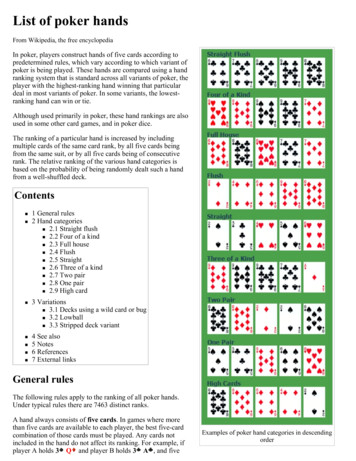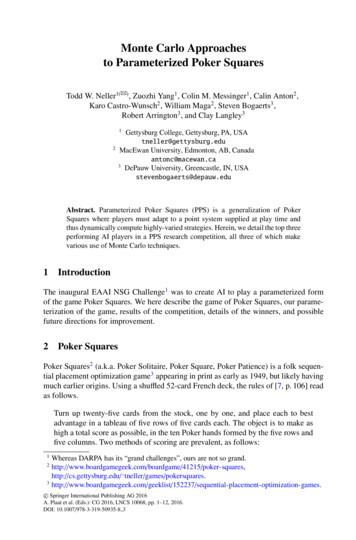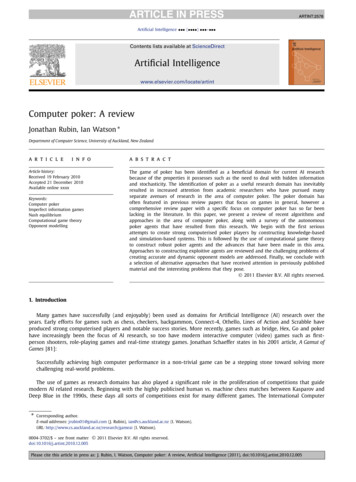
Transcription
List of poker handsFrom Wikipedia, the free encyclopediaIn poker, players construct hands of five cards according topredetermined rules, which vary according to which variant ofpoker is being played. These hands are compared using a handranking system that is standard across all variants of poker, theplayer with the highest-ranking hand winning that particulardeal in most variants of poker. In some variants, the lowestranking hand can win or tie.Although used primarily in poker, these hand rankings are alsoused in some other card games, and in poker dice.The ranking of a particular hand is increased by includingmultiple cards of the same card rank, by all five cards beingfrom the same suit, or by all five cards being of consecutiverank. The relative ranking of the various hand categories isbased on the probability of being randomly dealt such a handfrom a well-shuffled deck.Contents 1 General rules2 Hand categories 2.1 Straight flush 2.2 Four of a kind 2.3 Full house 2.4 Flush 2.5 Straight 2.6 Three of a kind 2.7 Two pair 2.8 One pair 2.9 High card3 Variations 3.1 Decks using a wild card or bug 3.2 Lowball 3.3 Stripped deck variant4 See also5 Notes6 References7 External linksGeneral rulesThe following rules apply to the ranking of all poker hands.Under typical rules there are 7463 distinct ranks.A hand always consists of five cards. In games where morethan five cards are available to each player, the best five-cardcombination of those cards must be played. Any cards notincluded in the hand do not affect its ranking. For example, ifplayer A holds 3 Q and player B holds 3 A , and fiveExamples of poker hand categories in descendingorder
cards 4 5 6 7 10 are available to both players, the players hold equally ranking 3-4-5-6-7 straights despitethe fact that the player B's ace ranks higher than the player A's queen.Individual cards are ranked A (highest), K, Q, J, 10, 9, 8, 7, 6, 5, 4, 3, 2 (lowest). Aces can appear low when partof an A-2-3-4-5 straight or straight flush. In the poker variants ace-to-five and ace-to-six lowball, the ace onlyplays low, and only plays high in deuce-to-seven lowball. Individual card ranks are used to rank hands that are inthe same rank category.The suits of the cards are used to determine whether a hand forms a flush or straight flush. In most variants, suitsdo not have an associated value, and play no part in determining the ranking of a hand. Sometimes a ranking calledhigh card by suit is used for randomly selecting a player to deal. Low card by suit usually determines the bring-inbetter in stud games.Hands are ranked first by category, then by individual card ranks; even the lowest hand that qualifies in a certaincategory defeats all hands in all lower categories. For example, 2 2 3 3 4 , the lowest-valued two pairhand, defeats all hands with just one pair or high card (such as A A K Q J ). Only between two hands inthe same category are card ranks used to break ties.A poker hand has the same hand ranking regardless of the order in which it is arranged by the deal, by adescription, or by a picture. So a hand arranged as 10 8 10 6 10 is ranked the same as 10 10 10even though in the first hand the three of a kind is not immediately obvious.86If there are multiple hands of the same rank at the showdown, the pot is divided equally between the winningplayers.There are 311 875 200 ways (5-permutations) of being dealt five cards from a 52 card deck,[Note 1] but since theorder of cards does not matter, there are 5! 120 5-permutations giving any one hand, so there are onlypossible distinct hands.Hand categoriesStraight flushDefeatsA straight flush is a hand that contains five cards in sequence, all ofthe same suit, such as Q J 10 9 8 . Two such hands arecompared by their card that is ranked highest. Because suits have norelative value, two otherwise identical straight flushes tie (so 10 98 7 6 ties with 10 9 8 7 6 ). Aces can play low instraights and straight flushes: 5 4 3 2 A is a 5-high straightflush, also known as a "steel wheel".[1][2] An ace-high straight flushsuch as 10 J Q K A is known as a royal flush, and is thehighest ranking standard poker hand.There are 40 possible straight flushes, including the four royal flushes.The probability of being dealt one in a five-card deal[Note 2] is.Ties withStraight flush examples
Four of a kindFour of a kind, also known as quads, is a poker hand such as 9 99 9 J , which contains four cards of one rank, and anunmatched card of another rank. Quads with higher ranking cardsdefeat lower ranking ones. In community-card games (such as TexasHold 'em) or games with wildcards it is possible for two or moreplayers to obtain the same quad; in this instance, the unmatched cardacts as a kicker, so 7 7 7 7 J defeats 7 7 7 7 10 . Iftwo hands have the same kicker, they tie and the pot is split.DefeatsThere are 624 possible hands including four of a kind; the probabilityof being dealt one in a five-card deal is.Full houseDefeatsDefeatsDefeatsA full house, also knownas a full boat, is a handsuch as 3 3 3 6 6 ,which contains threeFour of a kind examplesmatching cards of onerank, and two matchingcards of another rank. Between two full houses, the one with thehigher ranking three cards wins, so 7 7 7 4 4 defeats 6 6 6A A . If two hands have the same three cards (possible in wildcard and community card games), the hand with the higher pair wins,so 5 5 5 Q Q defeats 5 5 5 J J . Full houses aredescribed as "Three full of Pair" or occasionally "Three over Pair"; QQ Q 9 9 could be described as "Queens over nines","Queens full of nines", or simply "Queens full".There are 3,744 possible full houses; the probability of being dealt onein a five-card hand is.Full house examplesFlushA flush is a poker hand such as Q 10 7 6 4 , where all fivecards are of the same suit. If the hand also has all the cards insequential order, it would be a straight flush. Two flushes arecompared as if they were high card hands; the highest ranking card ofeach is compared to determine the winner. If both hands have the samehighest card, then the second-highest ranking card is compared, and soon until a difference is found. If the two flushes contain the same fiveranks of cards, they are tied and split the pot, that is, suits are not usedto rank them.Flushes are described by their highest card, as in "queen-high flush" todescribe Q 9 7 4 3 . If the rank of the second card isDefeats
important, it can also be included: K 10 5 3 2 is a "king-tenhigh flush" or just a "king-ten flush", while K Q 9 5 4 is a"king-queen-high flush". However an alternate method of describing aflush can be utilized specifically in community card games, like TexasHold 'em, where the highest ranking card in the flush sometimes willDefeatsbe a community card, and as such becomes irrelevant for its rank. Insuch situations, a person's flush might be described as being as high ashis hold cards. For example, consider that the community cards showA 10 6 2 , and Player A has hold cards of Q J while PlayerB has hold cards of K 10 . The A is playable by both andFlush examplesbecomes irrelevant in determining which player holds the higher flushso Player A's hand can be described as a queen high flush while PlayerB holds a king high flush. In this case, both players have a flush of the same suit, and because it is a communitycard game they have equal rights to the high ace, which consequently counteracts the ace being a meaningful highcard any longer. Because in games like five card draw, two players cannot have an ace high flush of the same suitand the former method is always used.There are 5,148 possible flushes, of which 40 are also straight flushes; the probability of being dealt a flush, whichis not also a straight flush, in a five-card hand is.StraightDefeatsA straight is a poker hand such as Q J 10 9 8 , whichcontains five cards of sequential rank. If the cards were also all of thesame suit, the hand would be a straight flush. Two straights are rankedby comparing the highest card of each. Two straights with the samehigh card are of equal value, suits are not used to separate them.Straights are described by their highest card, as in "ten-high straight"or "straight to the ten" for 10 9 8 7 6 .A hand such as A K Q J 10 is an ace-high straight (alsoknown as Broadway), and ranks above a king-high straight such as KQ J 10 9 . The ace may also be played as a low card in a fivehigh straight such as 5 4 3 2 A , which is colloquially knownas a wheel. The ace may not "wrap around", or play both high and low:3 2 A K Q is not a straight.TiesThere are 10,240 possible straights, of which 40 are also straightflushes; the probability of being dealt a straight, which is not also astraight flush, in a five-card deal isStraight examples.It is impossible to have a straight hand without either a five card or a ten card.Three of a kindThree of a kind, also called trips or a set, is a poker hand such as 22 2 K 6 , which contains three cards of the same rank, plustwo unmatched cards. In Texas hold 'em and other flop games, three ofa kind is called a "set" only when it is composed of a pocket pair andone card of matching rank on the board (as opposed to two matchingDefeats
cards on the board and a third in the player's hand).[3]Higher-valued three of a kind defeat lower-valued three of a kind, soQ Q Q 7 4 defeats J J J A K . If two hands containthree of a kind of the same value, which is possible in games with wildcards or community cards, the kickers are compared to break the tie, so4 4 4 9 2 defeats 4 4 4 8 7 .There are 54,912 possible three of a kind hands in a five-card dealwhich are not also full houses; the probability of being dealt one in afive-card hand is.DefeatsThree of a kind examplesTwo pairDefeatsA poker hand such as J J 4 4 9 , which contains two cards ofthe same rank, plus two cards of another rank (that match each otherbut not the first pair), plus one unmatched card, is called two pair. Torank two hands both containing two pair, the higher ranking pair ofeach is first compared, and the higher pair wins (so 10 10 8 8 4defeats 8 8 4 4 10 ). If both hands have the same top pair,then the second pair of each is compared, such that 10 10 8 8 4defeats 10 10 4 4 8 . If both hands have the same two pairs,the kicker determines the winner, so 10 10 8 8 A beats 1010 8 8 4 . Finally, if both hands have the same two pair andsame kicker, the pot is split.Two pair are described by the higher pair first, followed by the lowerpair if necessary; K K 9 9 5 is described as "Kings overnines", "Kings and nines", or simply "Kings up" if the nines are notimportant.DefeatsThere are 123,552 possible two pair hands that are not also full houses;the probability of being dealt one in a five-card deal is.DefeatsTwo pairs examples
One pairOne pair is a poker hand such as 4 4 K 10 5 , which containstwo cards of the same rank, plus three other unmatched cards. Higherranking pairs defeat lower ranking pairs; if two hands have the samepair, the non-paired cards (the kickers) are compared in descendingorder to determine the winner.DefeatsThere are 1,098,240 possible one pair hands; the probability of beingdealt one in a five-card deal is.DefeatsOne pair examplesHigh cardDefeatsA high-card or no-pair hand is a poker hand such as K J 8 7 3, in which no two cards have the same rank, the five cards are not insequence, and the five cards are not all the same suit. Essentially, nohand is made, and the only thing of any potential meaning in theplayer's hand is their highest card. Nevertheless, they sometimes win apot if the other players fold or even at a showdown. Two high-cardhands are ranked by comparing the highest ranking card. If those areequal, then the next highest ranking card from each hand is compared,and so on until a difference is found.High card hands are described by the one or two highest cards in thehand, such as "king high", "ace-queen high", or by as many cards asare necessary to break a tie. They are also referred to as "nothing","garbage", and other derogatory terms.DefeatsHigh card examplesThe lowest possible high card is seven-high (such as 7 5 4 3 2), because a hand such as 6 5 4 3 2 would be a straight, andin 6 5 4 3 A the ace would serve as the high card.Of the 2,598,960 possible hands, 1,302,540 do not contain any pairsand are neither straights nor flushes. As such, the probability of beingdealt "no pair" in a five-card deal isVariationsDecks using a wild card or bug.
The use of a joker as a bug creates a variation to game play. When a joker is introduced, it most commonlyfunctions as a fifth ace, unless it can be used to complete a flush or straight. Some casino draw poker variants use ajoker, and thus the best possible hand is five of a kind aces, or A A A A J with the joker representing thefifth ace. In lowball, the joker plays as the lowest card not already in the hand. In non-casino settings the joker issometimes a full wild card.LowballMain article: Lowball (poker)Some variants of poker called lowball or low poker are played with the standard hand rankings described here,but with the objective reversed: players strive not for the highest ranking of the above hands but for the lowestranking hand. There are several methods of ranking low hands, including ace-to-five low, deuce-to-seven low, aceto-six low and deuce-to-six low. The ace-to-five (known as California lowball) is used in razz, in some draw pokervarieties, and in deuce-to-seven (known as Kansas City lowball).Stripped deck variantFive-card draw poker is sometimes played with a stripped deck. This variant is commonly known as "seven-toace" or "ace-to-seven" (abbreviated as A-7 or 7-A). It can be played by up to five players. When four or fewerplayers play, a normal 32-card deck without jokers, with ranks ranging from ace to seven, is used. With fiveplayers, the sixes are added to make a 36-card deck. The deck thus contains only eight or nine different card ranks,compared to 13 in a standard deck. This affects the probabilities of making specific hands, so a flush ranks above afull house and below four of a kind in the seven-to-ace five-card draw. Many smaller online poker rooms, such asBoss Media spread the variant, although it is unheard of in land casinos.See also Glossary of poker termsList of poker hand nicknamesNon standard poker handsPoker probability – various probability calculations on poker handsNotes1. In general, the number of k-permutations taken from a set of n is,which in this case gives2. Note that the probabilities will vary slightly in games where the player can select from more than five cards (such asTexas Hold'em and Omaha), as the player is able to select the best possible hand from the cards available.References1. "Glossary". PokerTips.com. http://www.pokertips.org/glossary/w/STEEL WHEEL. Retrieved 2007-12-20.2. "Poker dictionary". PokerWorks.com. .html. Retrieved 2007-1220.3. Sklansky, David. Small Stakes Hold 'Em (1 ed.). p. 127. Elkan Allan & Hannah Mackay (2007-10-18). The Poker Encyclopedia. Anova. ISBN 1906032092.Krieger, Lou (2006). The Poker Player's Bible. Struik. p. 249. ISBN 9781770074699.Wolpin, Stewart (1990). The Rules of Neighborhood Poker According to Hoyle. New Chapter Press. p. 335.ISBN 9780942257199.
External links Printable chart of poker hand rankings (.pdf format)Retrieved from "http://en.wikipedia.org/wiki/List of poker hands"Categories: Poker hands This page was last modified on 8 September 2010 at 07:42.Text is available under the Creative Commons Attribution-ShareAlike License; additional terms may apply.See Terms of Use for details.Wikipedia is a registered trademark of the Wikimedia Foundation, Inc., a non-profit organization.
In poker, players construct hands of five cards according to predetermined rules, which vary according to which variant of poker is being played. These hands are compared using a hand ranking system that is standard across all variants of poker, the player with the highest-ranking hand winning that particular deal in most variants of poker.










